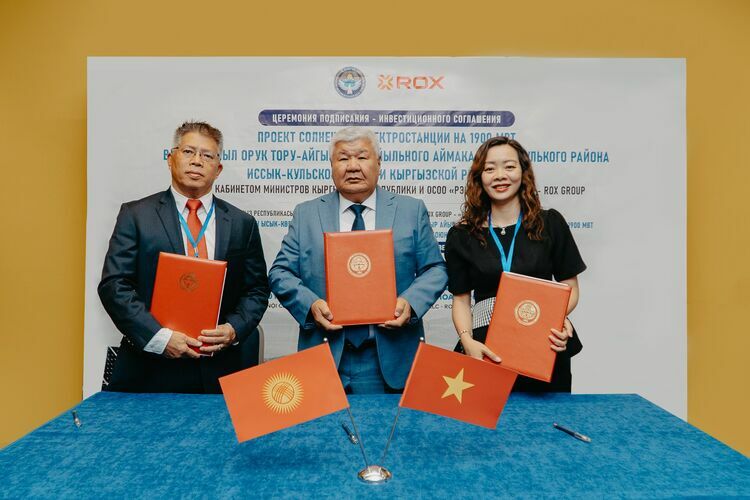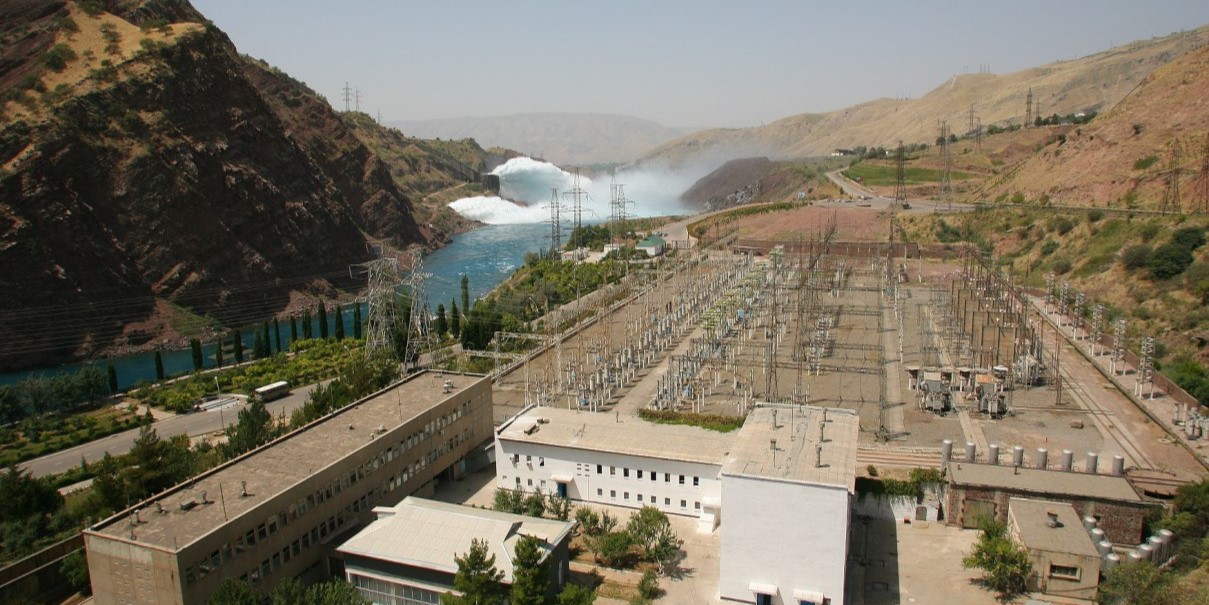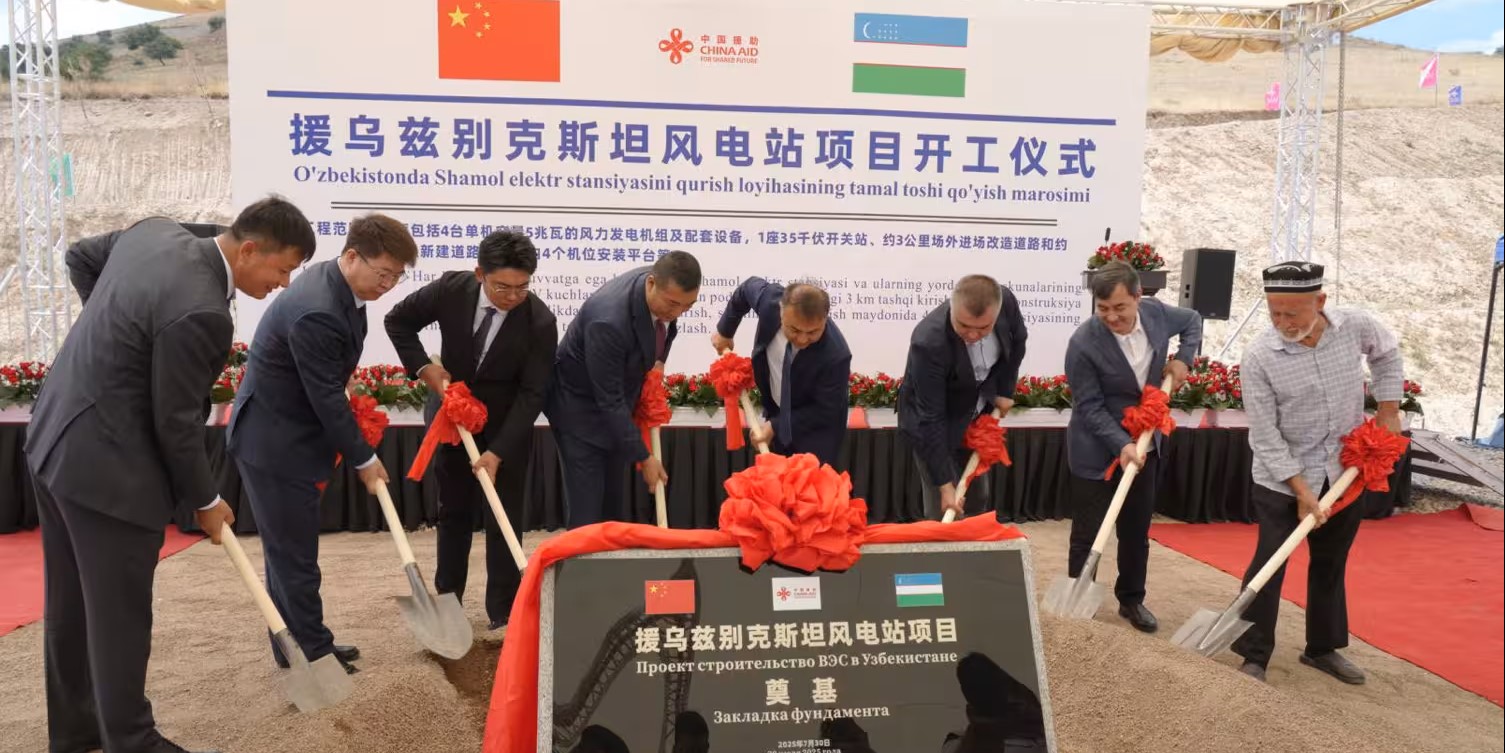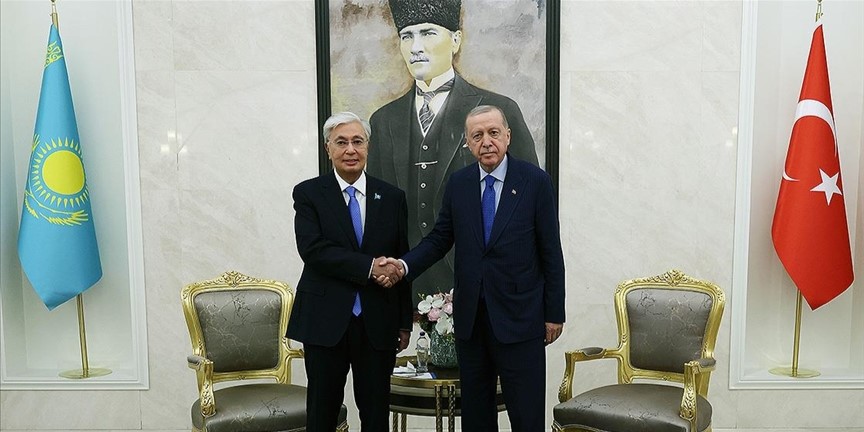This week, the media across Central Asia covered several critical energy stories. For instance, Kazakhstan announced that China would build its third nuclear power plant (NPP), Afghanistan began constructing a 40 MW solar power plant, Kyrgyzstan finalized an investment with a Vietnamese company to build a 1900 MW wind power plant in the country’s Issyk-Kul region, and Tajikistan reported an increase in electricity production despite planning to reduce exports to Afghanistan by 25% this winter. They also reported on important diplomatic events, such as Kazakhstani President Kassym-Jomart Tokayev’s visit to Türkiye. Lastly, several outlets noted that the Asian Development Bank (ADB) upgraded its 2025 GDP forecast for Central Asia, and the Kazakhstani National Fund is significantly diversifying its asset portfolio away from foreign currencies.

Kyrgyzstan and the Vietnamese company, ROX Group, signed an investment deal to construct a 1900 MW wind power plant in the Issyk-Kul region. Source: 24.kg
Energy:
Afghanistan began constructing a 40 MW solar power plant in the Logar Province last week (Daryo). The Deputy Prime Minister of the country’s Taliban government, Abdul Ghani Baradar, launched the $36 million project on July 31. The new solar power plant will alleviate electricity shortages and support the region’s economic development. Besides the 40 MW solar power plant, the project also involves the construction of a new 126 MVA substation and transmission lines at a cost of $7.6 million. Construction will last approximately 18 months. When complete, the plant will provide electricity to 40000 homes. According to the national utility provider, Da Afghanistan Breshna Sherkat, only 40% of Afghanistan’s population has access to electricity. The country heavily relies on imports from neighbouring countries, such as Tajikistan and Iran.
The Kyrgyzstani government and the Vietnamese ROX Group recently signed an investment agreement regarding the planned 1900 MW solar power plant in the Issyk-Kul region (24.kg). The project aims to address the country’s seasonal electricity shortages and bolster sustainable economic growth. ROX group expressed their readiness to commence construction in the near future. Currently, they are involved in building the Royal Central Park multifunctional complex at Ak-Kula hippodrome in Bishkek and renovating the Ai-Peri hotel. Earlier, we reported that the government approved the investment agreement. However, several details about the project, such as its cost, remain unclear.
Kazakhstan’s First Deputy Prime Minister, Roman Skylar, recently announced that China will construct Kazakhstan’s third nuclear power plant (NPP) (Kazinform). Previously, the government revealed that Russia’s Rosatom would lead the international consortium building the country’s first NPP near the Ulken village on the shores of Lake Balkhash. They also confirmed that China’s CNNC would lead the construction of the second NPP, but did not specify a location. He added that the Atomic Energy Agency and Electric Nuclear Power Plants are reviewing several possible sites and will announce the final locations for the second and third plants this year. Potential sites include Kurchatov, near the former Semipalatinsk nuclear test site in eastern Kazakhstan, and Aktau in the Mangystau region.
Electricity production in Tajikistan increased by 12.2% to 11.8 billion kilowatt-hours in the first six months of 2025 (Asia Plus). Nevertheless, electricity bills worth $468 million remain unpaid. TALCO, the Agency for Land Reclamation and Irrigation, and Tajikvodokanal are the largest debtors. Overall, electricity arrears have risen 8.2% compared to the same period in 2024. Additionally, electricity exports increased 56.4% compared to the first half of 2024, reaching 1.12 billion kilowatt-hours or 322.6 million somonis. Afghanistan imported 718 million kilowatt-hours worth 312 million somonis, Uzbekistan received 395.8 million kilowatt-hours worth 9 million somonis, while other countries obtained 9.5 million kilowatt-hours worth 1.6 million somonis. Electricity losses across the grid accounted for 2.26 billion kilowatt-hours or 17.2% of total output, a 3.3% drop from last year. Meanwhile, crude oil extraction increased while natural gas production fell between January and June (Asia Plus). At the same time, the CEO of Afghanistan’s national utility company, Da Afghanistan Breshna Sherkat, Abdul Bari Omar, divulged that Tajikistan would reduce electricity exports to Afghanistan by 25% during the coming winter due to supply shortages and increasing domestic seasonal demand (Asia Plus). Last winter, Tajikistanis living in rural areas received electricity for only three hours in the morning and five hours in the evening. These shortages come as electricity demand increased by 80 MW this year, and hundreds of thousands of Afghans have been expelled from neighbouring countries in recent months. Tajikistan supplies around 150 MW or 1.5 billion kilowatt-hours of electricity to Afghanistan annually under a 20-year deal signed in 2008. Every year, the two countries agree on an additional protocol outlining electricity deliveries for the coming year. Recent reports indicate that imports from neighbouring countries meet half of Afghanistan’s daily electricity demand (720 MW out of 1500 MW).

Despite increasing electricity production, Tajikistan will cut exports to Afghanistan by 25% this winter. Picture: Nurek Dam. Source: Asia Plus
Construction of the 20 MW Charvak wind power plant in Bostanlyk district, Tashkent region, began this week (Daryo). China is financing the project with a $28 million grant. The Chinese company TBEA is constructing the new wind farm in collaboration with Uzbekhydroenergo and expects to complete the plant by 2026. Deputy Minister of Energy of Uzbekistan, Umid Mamadaminov, and the Economic and Commercial Department Counsellor at the Chinese embassy, Sun Yang, attended the groundbreaking ceremony. The plant will generate 50 million kilowatt-hours of electricity per year and power 20000 households. The wind farm will also reduce fossil fuel consumption, lowering natural gas usage by 811,100 cubic meters or coal use by 3,150 tons annually. Uzbekistan is rapidly expanding its renewable energy output. Previously, it was reported that renewable sources account for around 17% of the country’s electricity output as of May 2025 (Kun). According to President Mirziyoyev, wind, solar, and hydropower will generate 54% of Uzbekistan’s electricity by 2030 (Interfax).

Uzbekistan commenced constructing a 20 MW wind farm in Tashkent this week. Source: Daryo
Kazakhstan has resolved to construct three new thermal energy plants in Kokshetau, Semey, and Ust-Kamenogorsk, after the Russian company, Inter RAO, previously contracted to build the plants, failed to obtain the necessary low-interest export finance (Kursiv). Announcing the news, First Deputy Prime Minister Roman Skylar confirmed that Samruk Energy has already started constructing the plant in Kokshetau. He added that if Inter RAO manages to secure financing, it can still participate in the other two projects. The new TPPs will operate without government subsidies. In April 2024, the Kazakhstani and Russian governments agreed to construct the three TPPs for $2.2 billion, with a planned capacity of one gigawatt.
Diplomatic Events:
The fifth meeting of the Kyrgyzstani-Pakistani Intergovernmental Commission on Trade, Economic, Scientific, and Technical Cooperation occurred in Islamabad last week (Akchabar). Deputy Prime Minister Edil Baysalov led the Kyrgyzstani delegation, while Pakistan’s Minister of Energy, Sardar Awais Ahmad Khan Leghari, led the Pakistani delegation. Officials discussed strengthening trade ties between their countries and implementing earlier agreements. After their deliberations, the Director of Kyrgyzstan’s Centre for Halal Industry Development, Almaz Kayyrbekov, and officials from Pakistan’s Halal Authority signed a memorandum of understanding (MoU) on reducing obstacles and barriers to the trade of Halal food products between the two countries and mutually recognizing certification procedures. Kyrgyzstan’s National Investment Agency and Pakistan’s Investment Council also concluded a memorandum of cooperation (Daryo). In addition, Kyrgyzstan’s Centre for Standardization and Metrology and Pakistan Standards and Quality Control Authority finalized a memorandum of cooperation on quality control and standardization. Lastly, both sides agreed to a protocol outlining their shared priorities.

The 5th Session of Pakistan - Kyrgyzstan Inter-Governmental Commission was held on July 28-29. Source: Daryo
Kazakhstan's President Kassym-Jomart Tokayev visited Türkiye on July 29 (The Times of Central Asia). After his arrival, he visited the mausoleum of Mustafa Kemal Atatürk, before co-chairing the fifth meeting of the Türkiye-Kazakhstan High-Level Strategic Cooperation Council with his Turkish counterpart, Recep Tayyip Erdoğan. They considered regional integration, trade, energy, transport, agricultural, defense industry, AI, IT, mining, and higher education cooperation. Furthering collaboration between their respective countries, they signed a joint declaration and 18 bilateral agreements (Kazinform). In their remarks, both leaders emphasized growing bilateral trade. President Tokayev would supply an additional 34 products worth $1 billion to the Turkish market annually (Kazinform). They also examined the development of the Trans-Caspian International Transport Route, with President Tokayev encouraging Turkish firms to invest in the region’s transport infrastructure. Considering their cooperation in the energy field, President Tokayev noted that Kazakhstan currently transports 1.4 million tons of oil through the Baku-Tbilisi-Ceyhan pipeline. Moreover, KazMunayGas (KMG) and Turkish Petroleum Corporation (TPAO) signed a cooperation agreement covering geological exploration and hydrocarbon extraction (Kazinform). KazMunayGaz Chairman Askhat Khassenov and Chairman and General Manager of TPAO Ahmet Türkoğlu signed the agreement on the sidelines of the visit. They also discussed technological exchanges and personnel training. Working groups from the two companies are currently analyzing multiple potential oil and gas deposits (Kazinform). President Tokayev also invited Turkish firms to create a joint fund to invest in mining projects in Kazakhstan (Kazinform). The Turkish Maarif Foundation revealed it would open two new schools in Astana and Almaty during the visit. At the same time, Gazi University would also open a branch in the country (The Times of Central Asia).
Both countries aim to expand bilateral trade turnover to $15 billion annually in the short term (Kazinform). However, trade between the two countries only reached $5 billion last year. They have committed to developing the Middle Corridor, with Türkiye investing $100 million in constructing logistics terminals in Kazakhstan. In the first four months of 2024, Kazakhstan invested $610 million in the Turkish economy, with trade until May amounting to $1.9 billion. Meanwhile, roughly 4000 Turkish firms have also invested $6 billion across a range of sectors in Kazakhstan (Kazinform). While 863,000 tourists from Kazakhstan visited Türkiye, a 4.5% increase, and 130000 Turkish tourists visited Kazakhstan last year, the Kazakhstani government will extend the visa-free stay for Turkish citizens to 90 days (Kazinform). Additionally, 12000 Kazakhstani students are studying at Turkish universities, supported by various scholarship programs, including Bolashak and Türkiye Bursları. Concluding the talks, President Erdoğan awarded President Tokayev Türkiye’s highest state award, the Devlet Nişanı Order (Kazinform).
During his visit, President Tokayev held talks with the heads of several Turkish enterprises operating in Kazakhstan. He met with the CEO of YDA Holding, Hüseyin Arslan (Kazinform). They discussed the company’s activities in Kazakhstan, specifically the construction of three hospitals in Turkistan, Astana and Petropavlovsk. He also met the Chairman of the Board of S Sistem Lojistik, Hüseyin Barlin (Kazinform). They discussed the expansion of the Middle Corridor. They considered the company’s establishment of a logistics center at Aktobe International Airport and its plans to expand to Shymkent, Almaty, and Astana. During his visit, he also met the Chairman of the Board of Directors of Orzax Group, Selman Alimoğlu (Kazinform). The firm plans to invest $40 million and employ 500 people at a new dietary supplement factory in Turkistan. Kazakhstan also concluded a deal with the Turkish company Tiryaki Holding, which will invest 160 billion tenge in wheat and vegetable processing plants in Kazakhstan (Kazinform). Both countries are implementing 23 agricultural projects worth $1.3 billion, with 18 already completed.

Kazakhstani President Kassym-Jomart Tokayev visited Türkiye on July 29 to co-chair the fifth meeting of the Türkiye-Kazakhstan High-Level Strategic Cooperation Council. Source: Anadolu
Inflation:
In July, Uzbekistan’s annual inflation rate edged higher from 8.7% to 8.9% (bne IntelliNews). However, annual inflation remains lower than the 10.2% rate registered in July 2024. Meanwhile, monthly inflation fell for the second consecutive month by 0.2% because of the seasonal decline in food prices, which dropped by a percent in the month. Nevertheless, annual food inflation surged to 6.5%, up from 2.9% in July 2024. Inflation for the first seven months of 2025 was 4%, down slightly from the 4.9% recorded over the same period in 2024. Non-food goods rose 0.2% compared to June and at an annual rate of 7.1%. Services increased by 0.9% month-on-month and 16.3% year-on-year. The increase in service prices has once more been attributed to rising utility costs, with housing and communal services skyrocketing 7.5%. The Eurasian Development Bank forecasts inflation to decrease to 8.1% in 2025, 6.8% in 2026, and 5.4% in 2027.
Transport:
Iran plans to launch new rail routes to Central Asia, including Merv in Turkmenistan and Dushanbe in Tajikistan (The Caspian Post). The Director General of Iran’s National Railway Company, Jabbar Ali Zakeri, recently announced the move but did not specify when the routes would commence. The new routes reflect ongoing efforts to boost regional connectivity and cooperation. He added that they would also launch routes to Herat in Afghanistan and Ankara in Türkiye. He also highlighted plans to operate tourist trains on these routes. Additionally, he noted that while Iran constructs up to 300 kilometers of new tracks annually, it must upgrade its rolling stock. Thus, he confirmed that Iran will receive 300 new passenger cars from China this year.
Economic Forecasts:
Last week, the Asian Development Bank (ADB) raised its 2025 GDP growth forecast for Central Asia and the Caucasus to 5.5% (Kursiv). This updated forecast represents a slight increase from its earlier April forecast of 5.4%. Having said that, they also anticipate growth to slow to 5.1% in 2026. The ABD credited the improved outlook to strong domestic demand and increased oil production. However, they cautioned that the region remains exposed to rising global uncertainty regarding trade and commodity prices in the medium term. Nevertheless, the region’s growth is higher than the 4.7% predicted for the Asia-Pacific region as a whole, although this figure is down on the 4.9% anticipated in April. They also expect growth in the broader region to drop to 4.6% in 2026. In addition, they expect inflation to hit 7.8% across Central Asia and the Caucasus, up from the 6.9% predicted in April. However, they added that annual inflation will slow to 6.7% in 2026. In their July Outlook Update, they remarked that Uzbekistan is more exposed to U.S. tariff measures than its neighbours due to its increasing integration into global markets and supply chains and its burgeoning light manufacturing and textile exports (Kursiv). They warned that the restrictions are more likely to affect those countries re-exporting or processing Chinese goods, such as Uzbekistan, than commodity-exporting countries like Kazakhstan and Turkmenistan. As a result, exports and foreign direct investment could be negatively impacted. They recommended greater diversification of export markets and supply chains to limit exposure to trade restrictions.

The share foreign currency component in the asset portfolio of Kazakhstan’s National Fund. Source: Kursiv
According to Kursiv, the share of foreign currencies in the assets of Kazakhstan’s National Fund fell to approximately 89% by the end of 2024 (Kursiv). The Kazakhstani government initially established the National Fund to combat the effects of “Dutch disease,” the negative impact on an economy from an overreliance on natural resource revenues. By investing petrodollars abroad, the National Fund would moderate fluctuations in natural resource revenues, mitigating the adverse effect of any downturn in commodity prices on the national economy. The Fund balances potential fiscal deficits and provides for current budgetary spending through the stabilization portfolio, while the savings portfolio provides for long-term investments. The researchers attributed this decline in the share of foreign currencies to the government increasingly relying on the National Fund to finance infrastructure investment and the national budget. In 2024, while the fund’s assets in tenge grew by 18% to 35.2 trillion (16% to 34.7 trillion when adjusted for liabilities), growth in U.S. dollar terms, the fund’s base currency, was meagre at 1% to $66.2 billion. Meanwhile, the fund’s foreign currency assets fell by 2% to $58 billion. They valued the stabilization portfolio at $3.4 billion and the savings portfolio at $56.1 billion. In 2024, the National Bank turned a profit of 7.6%, the stabilization portfolio reported 5.28%, above its benchmark of 5.20%, and the savings portfolio recorded 8.11%, above its benchmark of 7.97%. Previously, large government deficits and withdrawals alongside low investment returns restrained growth. In 2024, government withdrawals amounted to around $12 billion or 4.4% of GDP. Nevertheless, the growth of most asset classes, besides government bonds issued by developed economies, and the transition from a conservative to an increasingly diversified set of assets contributed to increased growth. The fund transitioned from 80% in bonds issued by developed economies and 20% in equities to 60% in bonds, 30% in equities and 10% in alternative instruments and gold. Additionally, cumulative investment income came to 127.75% or an average annual return of 3.55%, slightly below the 3.79% five-year average but higher than the 2.92% 10-year average. Last year, the fund’s revenues reached $18 billion, $8 billion from tax revenues and $15 billion from investment returns. Thus, the savings portfolio accounted for 84.7% of the fund’s net assets or about $62 billion. The bond portfolio increased by 17% to $34 billion, accounting for 55% of the savings portfolio. Equities rose 37% reaching $22 billion or 36% of the savings portfolio. Meanwhile, gold holdings grew slightly from 5.1% of all assets in 2023 to 5.9% or $3.6 billion in 2024. In addition, alternative instruments increased from $1.5 billion in 2023 to $1.7 billion or 2.5% of the savings portfolio in 2024. The stabilization portfolio fell from $8 billion or 7.9% of net assets to $3.8 billion or 5.2%. This diversification of assets away from bonds issued by developed economies towards gold and other instruments reflects ongoing uncertainty in the global economy, particularly around debt levels in developed economies, sanctions, and trade. Previous volatility in the tenge to dollar exchange rate meant foreign currencies were privileged in the Fund’s assets. However, the government enabled the National Fund to acquire domestic financial instruments in 2022, such as bonds issued by the National Welfare Fund, Samruk-Kazyna, and shares in state enterprises such as Kazatomprom or KazMunayGaz. In 2025, they revised this decision to only include bonds to fund national projects. For instance, the National Fund bought $507 million worth of bonds from Samruk-Kazyna to finance the Dostyk-Moiynty railway and the Taldykorgan-Usharal gas pipeline. In 2024, assets denominated in tenge reached $8 billion or 13% of all assets. Tenge assets have risen by 49% in the last year, increasing their share in the Fund’s portfolio by 4%. The rise in tenge denominated assets exposes the fund to greater risk and less scrutiny due to the tenge’s greater volatility and the lower transparency and return on these assets. For example, the bond purchase noted above incurred a loss of $150 million because the interest on these bonds was below market rates. The government is likely using the National Fund to shore up expenditure and investment as the global economy falters, risking its overall sustainability by investing in riskier assets.
Water Management:
At a July 28 meeting, Kazakhstan’s Deputy Prime Minister Kanat Bozumbayev and Kyrgyzstan’s Prime Minister Adylbek Kasymaliev agreed that Kyrgyzstan would provide additional water supplies to Kazakhstan to recoup losses during recent drought conditions (The Astana Times). Both countries consented to the August operational plan of the Naryn cascade, the Talas basin, and the Kirov and Orto-Tokoy reservoirs. Deputy Prime Minister Bozumbayev also met with Uzbekistani Prime Minister Abdulla Aripov to resolve water supply delays. The Kazakhstani Ministry of Water Resources and Irrigation also confirmed that Kazakhstan received 10.2 billion cubic meters of water from China in the first six months of the year (Kazinform). Kazakhstan received 4.6 billion cubic meters through the Yertis River and 5.6 billion cubic meters through the Ili River. As a result, the Kapchagai reservoir reached full capacity, and they released 8.52 billion cubic meters into Lake Balkhash. The level of Lake Balkhash rose by 12 centimeters in early 2025 from 341.55 meters to 341.87 meters. In March, Kazakhstan and China signed their first MoU concerning the sustainable development and distribution of transboundary water resources.

